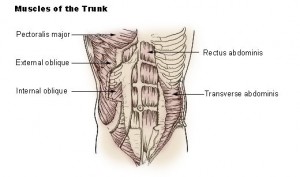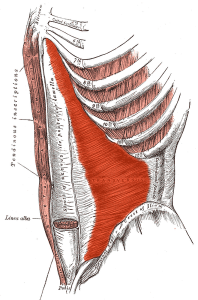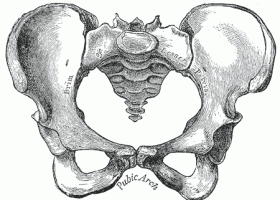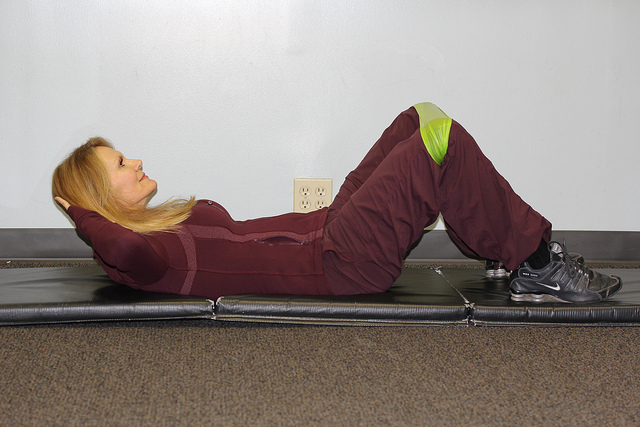A Dance Advantage reader recently sent me this question:
My teacher has us do crunches in class. Last week she told us that we had to keep our stomachs flat while we do them instead of letting them bunch up and that letting the muscles bunch up doesn’t really do anything. But I can’t do crunches without letting the muscles bunch up. I don’t understand what I’m doing wrong. Can you explain this to me?
Let’s look at what she’s asking you to do and why…

What your teacher is trying to help you to do is engage your deeper abdominal muscles as you perform a “crunch,” or abdominal curl. She is correct in encouraging you to do this because it is these deeper muscles that stabilize the spine and, when activated, support proper alignment.
Your abdominal muscles include several layers. Most of these actually wrap around your sides to the back of your body, though often we think of our abdominals only as that “six-pack” area at the front of the body. Those washboard-looking muscles are the rectus abdominus and are only one of four very important muscle layers of the torso/abdomen (the others are the internal and external obliques and the transverse abdominis – Fig. 1).
Bunching
When you perform a crunch and see that upper layer (the rectus abdominis) bunching up or pushing out, it means that the inner most layers, particularly the transverse abdominis, are not being activated. You are working/strengthening muscles, however, you are not working/strengthening the ones that will help you most in your dancing. The inner abdominal, and other core muscles are most important for executing movement (any kind of movement) with ease.
Deb Vogel from The Body Series, compares the core muscles to a wheel hub, her short and sweet explanation emphasizes why it is important for the core to be strong and stable. I also describe and discuss why the core or center muscles are important in this post called, The Core or Center
Strengthening
Increasing your core strength requires engaging the appropriate muscle groups in a regular (or habitual) way. You want to engage the core during all movement (not just during abdominal exercises). The action your teacher is really asking you to do when she says “flatten your stomach” in a crunch, is actually pretty much the same action she wants you to perform when she tells you to “pull up”… it’s just that in the crunch, you progress to a more intense concentric contraction that works against gravity.
Now, let’s talk about how to engage your core in a crunch and otherwise…

There are two important lengthening actions that engage the core support system. Often one or the other is overlooked, but both are necessary to create efficiency in movement. The first involves those inner layers of abdominal muscles, the other involves the muscles of the pelvic floor. Here are several methods of “finding it” for yourself — different ideas or thoughts work for different people.
Engaging the Pelvic Floor
Teachers sometimes find this an embarrassing topic but the muscles of the pelvic floor are extremely important in dance. Without going into much detail, let’s just try a few methods and images to help you discover how to engage them.
- Imagine and try to activate the same muscles you would use to stop urination (yes, as in “peeing”) mid-flow. Say hello to your pelvic floor muscles!
-

The sits bones (or ischial tuberosities) point downward. To narrow the pelvis think of bringing those two “loops” at the bottom of the pelvis together. If that’s too icky, try this: While standing with feet slightly apart, imagine and try to “narrow” the pelvis by bringing your sits bones (those two bones you feel against the floor when you sit up tall) closer together. You are not trying to squeeze your gluts (your “cheeks”) together. The sits bones hang down toward the floor.
- Another way to find this action is to sit up, tall in a chair. Don’t arch your back. Again, narrow the area between your sits bones that is in contact with the chair. It may help to also place the palms of the hands together and press as you draw inward and upward through the base of the body. You will physically grow taller when you do this.
Activating Your Inner Abdominals
To activate your inner abdominal muscles, start just above the pubic bone and moving toward the sternum, pull the abdominal wall inward and upward toward the center column of the body (the spine). You can try this lying down with knees up (as in your crunch position) or from standing. You might even try it lying on your stomach just to feel the abdominals lift away from the floor. Do this without changing the position of the back or pelvis, however.
Some like to think of this as bringing the belly button toward the spine. Others prefer to imagine that you are scooping out the abdominals like ice cream. Others like the image of lacing up the abdominals (my personal favorite because it reminds me that internal obliques (sides of the body) are being activated inward and upward as well).
Note that you may discover the engagement of your pelvic floor and inner abdominals all in one exploration – they often work together. For further explanation and guidance, check out this post by Deb Vogel on Abdominal Strength.
Now Back to the Crunch
- While lying on your back with your knees up, try to keep your spine neutral, meaning that it is neither pressed into the floor or arched in a swayed back. There will likely be a small space between the small of your back and the floor.
- Keep this alignment as you engage the pelvic floor and activate the inner abdominals. This may feel like work all on its own until these deeper core muscles strengthen and you get used to using them.
- From here, curl the upper body away from the floor. The idea behind a crunch is that you are adding resistance to an already activated core by lifting your shoulders. So, only lift the shoulders as much as you can without loosing everything else.
If you are keeping your core activated during the crunch, you will no longer see the “bunch!”
Nichelle Suzanne is a writer specializing in dance and online content. She is also a dance instructor with over 20 years experience teaching in dance studios, community programs, and colleges. She began Dance Advantage in 2008, equipped with a passion for movement education and an intuitive sense that a blog could bring dancers together. As a Houston-based dance writer, Nichelle covers dance performance for Dance Source Houston, Arts+Culture Texas, and other publications. She is a leader in social media within the dance community and has presented on blogging for dance organizations, including Dance/USA. Nichelle provides web consulting and writing services for dancers, dance schools and studios, and those beyond the dance world. Read Nichelle’s posts.


